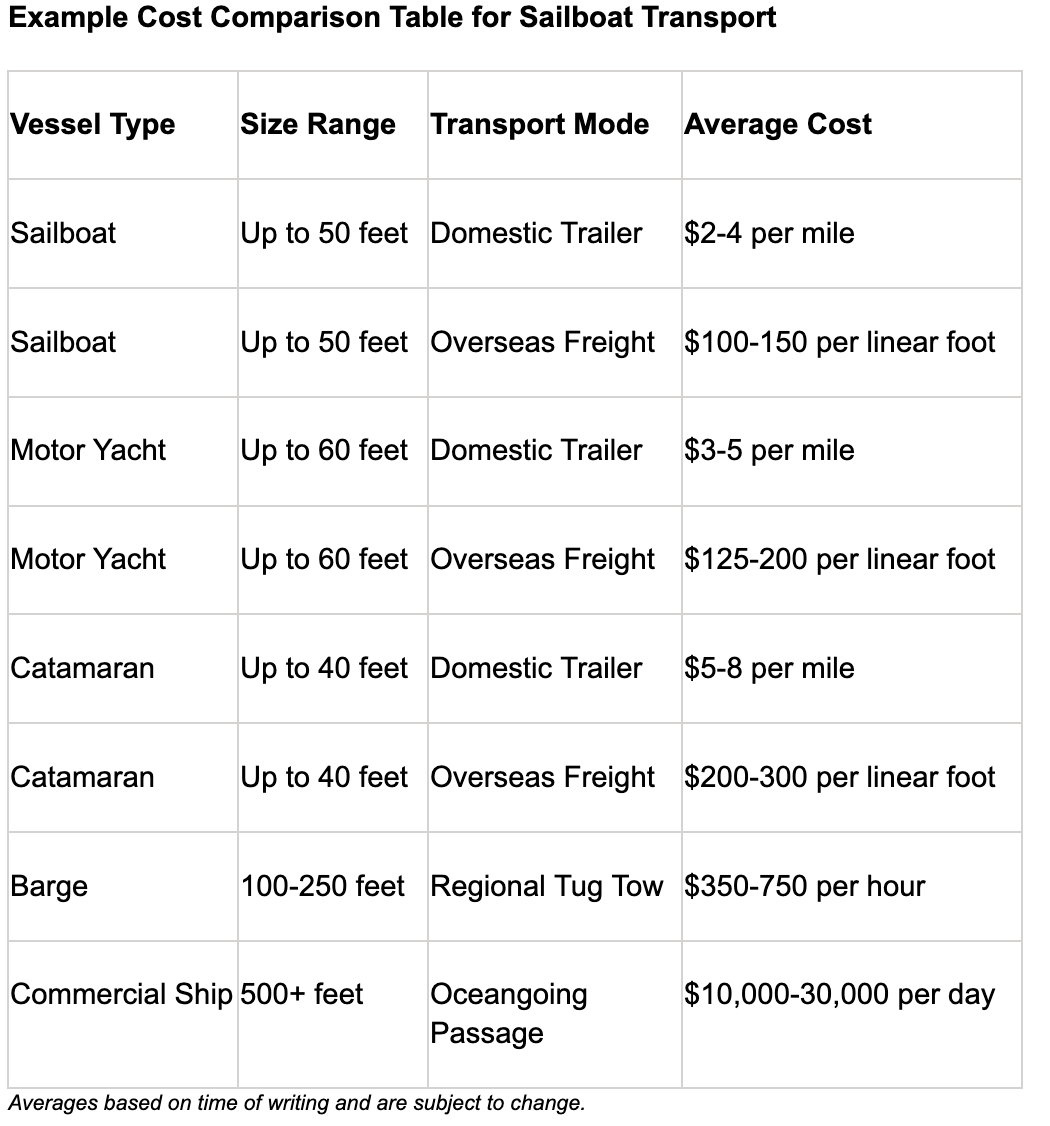Sailboat transport costs can get expensive, leaving some boat owners anchored down by high quotes. However, you can better navigate the process by understanding three basic things that impact price.
The first is size. Longer, more comprehensive, and heavier boats cost more to haul. A 40-foot sloop with a giant beam and deep keel needs a specialized truck and equipment to move, which adds to the bill.
The second is distance. Transporting a sailboat along coastal roads or inland waterways over a few hundred miles is far cheaper than an overseas voyage of a thousand miles or more. Crossing oceans with cargo ships or traversing canals also ups the rates.
Finally, how much sweat (or crane) equity is involved? Is the boat hauled on a trailer, requiring a big tow vehicle? Or does it need to be lifted out of the water by a marina travel lift and loaded onto a semi-truck? More labor and machinery needed means more dollars spent.
Keep the length, location, and lift method in mind when planning a sailboat transport and getting quotes. Understanding these key factors allows you to better balance cost savings with hitting the high seas on new adventures. The more prepared you are, the less likely you’ll be left adrift by surprising bills.
Do you want to discover more about the cost factors influencing sailboat transportation pricing? Take advantage of our in-depth guide analyzing additional considerations that impact sailboat shipping costs. We break down exactly what goes into transport pricing so you can confidently set sail.
A Quick Glimpse into the Sailboat Transportation Market
Sailboat transportation occupies a unique niche within the broader pleasure craft shipping and logistics industry. Unlike the mass-market sector of powerboat transport, the sailboat segment poses unique challenges that require specialized solutions.
On the most basic level, sailboats’ aerodynamics, projected appendages, and high centers of gravity present handling considerations compared to their powerboat counterparts. Masts must be unstepped, keels retracted or safely secured for overland travel, and windage addressed during open-deck delivery.
The Growth Forecast of Sailboat Transportation Services

The specialty sector of sailboat transport has been rising in recent years. Fueled by recreational boating and marine tourism growth, the boat and yacht shipping industry has seen consistent year-over-year expansion. Analysts project that the global boat transportation market will grow at a CAGR of over 5% through 2030.
Within this space, the sailboat segment specifically is buoyed by enthusiasm for self-powered pleasure craft among sailing purists and recreational enthusiasts. Whether trailering a small daysailer inland to a new lake or shipping a 50-foot cruiser to competitions abroad, sailboat owners demand specialized transport services to relocate their prized vessels.
North America represents the epicenter of recreational boating activity. With over 12 million registered pleasure boats, the United States tops global rankings for nautical leisure pursuits. Sailboats make up 15% of that total and rise annually by 2-4% based on new vessel registrations. Canada and coastal tourist destinations in Mexico also contribute to growing numbers.
As participation increases, sailboat owners are venturing further inland and across oceans — underlining the parallel need for qualified boat shipping and delivery companies. For specialized carriers and marina services, the unique handling requirements for sailboats versus powerboats also allow higher price margins. From customized insurance and hauling equipment to captained deliveries, the future outlook seems smooth sailing for the sailboat transport niche.
What Determines How Much It Costs to Ship Your Sailboat?
Transporting sailboats is a niche service requiring customized trailers, experienced crews, and careful handling. As such, shipping fees depend on several variables, including your craft’s size, delivery distance, transport modes, seasonal timing, and any supplementary coverage or activities. In this section, we’ll explore what makes certain sailboat deliveries more expensive than others.
Size Matters: Bigger Boats Equal Bigger Costs
The most significant determining factor around shipment cost is a sailboat’s size and weight. Longer lengths require upgraded trailers plus potential accessories like keel supports and height poles for clearing bridges safely. Heavier boats also consume more fuel during towing.
Meanwhile, oversized widths or tall masts may mandate special transit permits, detachable tower sections, escort vehicles for checking vertical clearances and rigging disassembly and reassembly. These processes all impact the bottom line. Boat volume also reduces how many can fit per trailer load. Thus, larger craft automatically jump brackets for premium delivery.
Distance Dictates Dollars
Common logic says sending a sailboat 3,000 miles from port to port rather than 30 miles will ratchet transport expenses. Extended distances burn more gas plus potentially lengthen transit damage risks and crew labor hours.
Specific challenging routes also contribute to pricing. If roads contain tricky elevation gains, highly congested metro areas, or winding country backroads requiring more cautious speeds to protect the boat, carriers factor this in. Harbor complexity, like a tight marina with awkward access, heightens costs, too, compared to open ramps.
Transport Type Sets the Tone
Sailboat shipping methods represent a spectrum when it comes to cost. Thanks to minimal fuel and rental expenses, overland transport via adapted trailers is the most affordable regional delivery option. Enclosed trailers offer further protection from road debris, too.
For overseas shipping, however, ocean freight costs escalate exponentially due to slow vessel fuel consumption over thousands of nautical miles. Ditto for aviation methods via cargo plane. Boat disassembly and customs paperwork also add to the tally for global transport.
Seasonality Shifts the Scale
During peak summer sailing times, shifting boats for regattas or regional cruising spikes demand, constraining carrier availability. Basic economics says limited supply and inflated demand results in higher pricing.
Come winter, meanwhile, transport frequency drops. While winter conditions introduce road dangers, ice buildup and storms may prompt discounts from carriers looking to fill unused trailer space. This cycle reaches equilibrium in the spring and fall shoulder seasons. So, schedule around seasonal rate fluctuations when possible.
Protection Has a Price
Finally, what supplemental insurance, handling services, winter storage needs or concierge accommodations get bundled together pushes the overall sailboat delivery quote upwards or down. Desired coverage limits make a difference, too.
Barebones shipping without frills runs the cheapest. But upgrades like white glove port drayage, haul-out lifting before/after overland segments, below deck shrink wrapping, and expanded liability for expensive craft provide peace of mind to match the premium rate. Calculate what’s most important for your situation’s needs.
With these critical variables around sailboat specifications, route geography, popular timing, and auxiliary provisions influencing the math, transport costs can fluctuate widely. But a mix of flexible timing, carrier competition, and custom bundles ensures smooth passages at a fair price point!
How Sailboat Shipping Rates Size Up to Other Vessels
When budgeting to relocate your cherished sailboat to a new home port or race event, it helps compare relative shipping expenses to other boat types and locations. From regional towing to worldwide freight, rates vary widely. Let’s contrast domestic and global transportation fees and see how sailing craft fees stack against comparable recreational or commercial vessel charges.
Regional Towing vs Oceanic Transit
For domestic shipping confined within one country, adapted trailers offer an affordable overland solution for sailboats under 50 feet. Enclosed options prevent road debris damage, while open trailers provide deck space access during long hauls. Typical per-mile charges apply based on mileage and any specialty permits.
Internationally, however, sailboats require deck space on maritime cargo ships for overseas transport. Around $100-150 per linear foot significantly boosts costs for extended global voyages. Speedier aircraft charters for masts/hardware offset slower boat passage but introduce steep air freight expenses. Customs paperwork and equipment dismantling/reassembly increase international quotes, too.
Sail Craft Compared to Comparable Vessels
Despite nuances like height clearances and mast vulnerabilities, sailboats transport slightly cheaper than comparable motor yachts thanks to their lighter hull materials and build. Multihull catamarans, in contrast, draw premiums for their extra-wide beams demanding oversized trailers.
For commercial vessels, large barges and fishing boats under 40 feet may quote similarly to sailboats during regional shipping. However, their dense steel construction adds extensive weight to fuel costs. Massive industrial ships dwarf recreational quotes, given cargo ships’ slow steaming speeds that take weeks.
The overriding factor across all vessel types remains to carry capacity. Solo light sailboats balance uniquely on their keel and thus limit how many groups are together on a trailer. By contrast, small 8-20 foot motorboats can stack together in rows of 4 to 6 atop standardized trailers for economy of scale. This spreads transport costs lower per boat. But tiny runabouts skip intricate stepped masts and fixed keels, too.
With geography, materials, size, and quantity impacting rates across boat segments, sailors can control shipping expenses through careful scheduling and transport mode choices. While rarely the cheapest option, sailboat delivery includes premium handling, reflecting their engineering intricacies and performance capabilities worth protecting.

Sailboats represent a middle ground for regional towing cost and complexity. On longer global ship passages, their lightweight hulls hold a slight edge over sturdy motor yachts. But custom catamaran trailers and massive cargo ships reside on transport pricing extremes.
Getting Your Sailboat Shipshape Before Transport

Relocating prized sailing craft over land requires extra precautions beyond routine vehicle transportation. Their soaring masts must clear tunnels and bridges while vulnerable keels brake properly on trailers. Materials also require sturdy shielding from road debris and stormy weather that risks expensive damage in transit. What steps should prudent captains take to promote safe, efficient sailboat transport?
Secure All Loose Elements From Shifting
Before loading onto any transport trailer, remove and carefully stow below deck all non-permanent hardware like detachable sail covers, canvas deck gear, and auxiliary motors or dinghies on davits that may sway in the wind. Separating easy-to-remove mast segments likewise prevents height issues while saving on clearance permits. Always securely lash down whatever heavy top-deck gear remains like boom appendages to prevent collision destruction from load shifts!
Wrap Vulnerable Sections in Protective Padding
Since loose road debris easily abrades costly gel coats and sensitive steering apparatus, wrap sturdy padded quilts around keels, rudders, and any extended mast segments prone to side scratches. Preventing exterior damage from gravel, rain, and salt spray saves major refinishing or equipment repairs upon arrival. For added protection, fully shrouding the entire craft in an anchored weather shield defends during open-air uncovered passages.
Inspect Trailer Load Balance and Capacity
Uneven boat weight distribution leads to dangerous fishing tendencies once at highway speeds. Thus, captains should always confirm adequate vertical hitch tongue weight presses down on trailer balls at 10-15% of the total load. Check whether the axle spacing suits your sailboat’s dimensions, with room to spare. Be prepared to adjust permanent ballast tanks and gear storage to redistribute concentrations and delicate tune equilibrium before departing.
Map Transport Route Height Clearances
Thoroughly measure the anticipated total transport height with the mast fully lowered. Compare these clearance calculations against bridge overpasses, signs, tunnels or overhead wires along your route. Proactively steer clear of troublesome low underpasses. Having a separate escort vehicle also helps spot potential issues in real time.
Coordinate Route Changes
Continually update captains on any evolving launch ramp access, harbor depths, bridge closures, storms, or customs inspection delays. Helping carriers adapt timing, deviations, checklists, and contingencies prevents wasted trips when hindrances emerge. Keep communication transparent!
How We Tackle Common Sailboat Shipping Headaches?
Don’t worry about your sailboat shipping. As specialized carriers, we’ve seen it all.
From unpredictable seas to faulty equipment, shipping mishaps can quickly scuttle dreams if not careful!
But with decades of specialized hauling, we also know tried and true tactics that help ensure smooth voyages ahead for any vessel. Read on for how we simplify five sailing headaches.
Just chart us your desired course and leave inclement weather, red tape, gear woes, and miscommunications in our wake!
Choosing the Right Transport Service
The safety of your vessel depends on selecting reliable and specialized sailboat transporters. Follow these essential tips to ensure your boat gets delivered undamaged:
- Verify the company specializes in sailboat transport. Choose providers that exclusively transport sailboats and understand their unique requirements. Ask about their experience.
- Inspect equipment and operators. The transport trucks, trailers, lifts, and other equipment should be suitable for delicate sailboats. Confirm operators are licensed and trained to handle specialty boats.
- Request local references. Ask for referrals from nearby sailing clubs and marinas. Fellow sailors can offer insights on responsiveness and how careful the company is.
- Analyze access challenges. Provide details on water access limitations and dock/ramp space at pickup and dropoff locations. This allows the transporter to dispatch proper equipment.
- Set detailed hauling plans. Map out precise plans covering preparation, loading, securing, transit routes, unloading, and cleanup. Discuss any special requirements.
- Establish contingency protocols. Ask what emergency response plans they have in case of storm delays, mechanical issues, or damage during transport. Make sure arrangements align with insurance policies.
- Get guaranteed cost estimates. Obtain binding quotes outlining all fees in writing rather than loose verbal estimates. This locks in pricing and prevents surprise charges.
- Understand pricing components. Request a breakdown of all costs, such as base transport fees, fuel surcharges, taxes, preparation and loading fees, insurance, etc. Make sure no significant elements are missing.
- Inspect vessels pre and post-haul. Do walkaround inspections with company reps before pickup and after delivery while still at the dock. Document any prior scrapes versus new damage from transit mishaps.
- Trust, but verify. While cheaper transporters may be tempting, qualified companies are worth the price. But don’t completely let your guard down. Monitor loading/unloading and follow the truck to watch for problems.
FAQs: Getting to the Bottom of Sailboat Shipping
We get many questions from anxious boat owners facing their first sailboat transport project. Let’s address some frequent areas of confusion:
How much advance notice is ideal for booking sailboat hauls?
We recommend giving at least 2-3 weeks lead time. This lets us match you with the best-specialized carrier to accommodate your custom plan. Last-minute rush shipping is still possible but will incur premium fees.
What factors most impact the cost of sailboat transport?
Major cost drivers are:
- Distance/fuel.
- Boat size, including height for clearing bridges/wires.
- Route accessibility challenges.
- Marina space limitations.
- Any specialty equipment needed for loading unique vessels.
We provide guaranteed quotes accounting for these.
Is it safe to ship my precious boat with strangers?
Our entire business depends on safely handling our customers’ costly boats. All our transport partners are thoroughly vetted specialists rated highly for responsiveness and care. We also provide contingency insurance.
How are pricing quotes determined?
We customize quotes based on your exact boat specifications, loading/unloading considerations, route, and any special requirements you indicate, such as emergency storm evacuation timing. There are no hidden fees – our quotes encompass all taxes, insurance, fuel surcharges, etc.
How to Keep Sailboat Shipping Costs Down?
While specialized carriers with proper equipment for safely transporting unique sailboats can’t compete on price with amateur haulers, here are tips for keeping uShip’s quotes affordable:
- Offer schedule flexibility to secure the best transport match and rates beyond just faster premium shipping
- Consider transporting during off-peak seasons when demand is lower
- Research marina accessibility challenges to highlight for quotes rather than assume it is no big deal
- For overseas shipping, be open to multi-leg relay transport combinations to reduce sea freight
- Ask if any truck equipment rentals like trailers or specialty slings/pads can save costs over contracted quotes
- Highlight easy accessibility factors that minimize complications
- Take advantage of member rewards programs and any limited-time uShip promos
Conclusion
Transporting sailboats requires specialized carriers to navigate tricky logistics from preparations to securing multi-ton vessels for traversing tight spaces — experienced outfits like uShip tap expert knowledge on handling sailboat nuances. Custom plans also ensure boats are better than generic freight movers.
The specialized white-glove service warrants a premium investment for most sailors. Communicate unique access hurdles and budget needs upfront.
Advanced preparation remains paramount — clearing decks, checking insurance, and charging batteries. Perform thorough pre/post-transport inspections and document damages to protect against unfair liability claims.
Inevitably, hiccups happen, but the best transport crews have contingency protocols and backup equipment. Getting boats relocated without damages or budget overages requires a seasoned outfit focused on sailboat shipping intricacies.
Following these essential tips will help ensure smooth sailing ahead to your boat’s next adventure-filled anchorage!
People Also Ask (PAA)
How is the cost of transporting a sailboat determined?
Distance, size/weight, equipment needs, marina access limitations & special handling requirements determine costs. Transport companies provide custom quotes.
What is the average price to transport a sailboat across the country?
The average is $3-5/mile for midsize boats – so about $1,200-$2,000 across the country. Larger vessels run $6-12/mile.
Does the size of the sailboat affect transportation costs?
Yes, size significantly impacts costs due to truck/trailer needs, lifting equipment, bridge clearances, etc. Wider beams and taller masts increase prices.
How do I prepare my sailboat for transportation?
Prepare by securing the mast, removing sails, clearly marking lift points, emptying tanks & clearing the deck—also, document prior damage.
What should I look for in a sailboat transport service provider?
Look for companies specializing exclusively in sailboats with proper equipment, experienced captains, marine insurance, and contingency protocols.
Are there any hidden costs in sailboat transportation?
There should not be hidden charges. Reputable providers give transparent quotes covering all taxes, insurance fees, fuel surcharges, etc.
How does international sailboat transport differ from domestic?
International transport involves customs processes that may require fees, documentation, duty taxes, and import inspections at foreign ports.
Can I transport my sailboat during the winter?
Yes, winter transport is possible, but it may have higher risks and limitations, such as needing special planning for snow, road salt, freezing equipment, etc.



